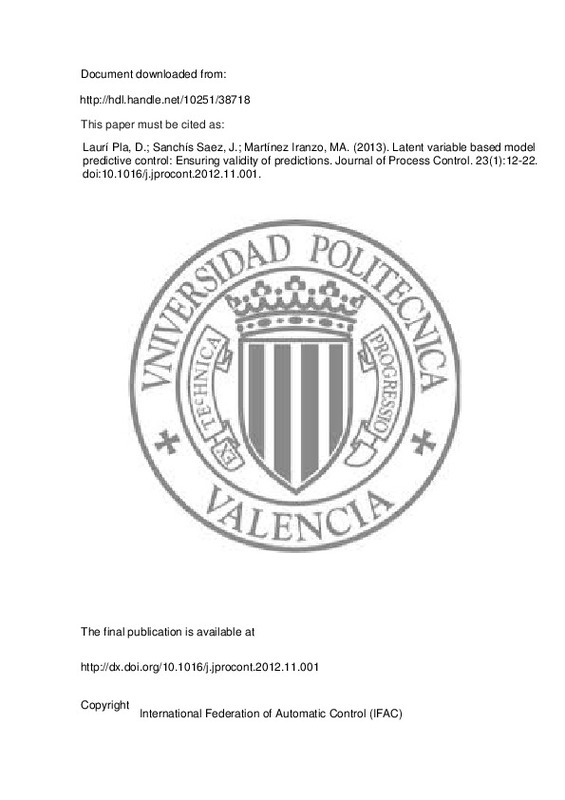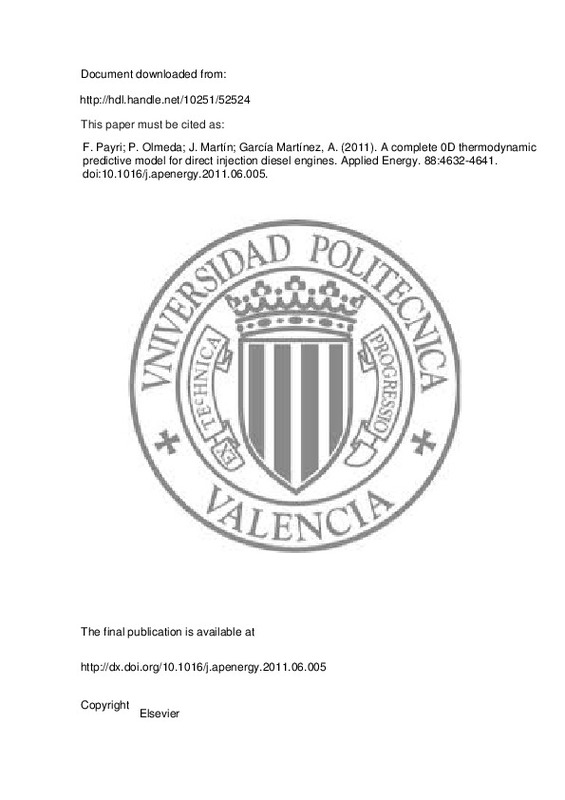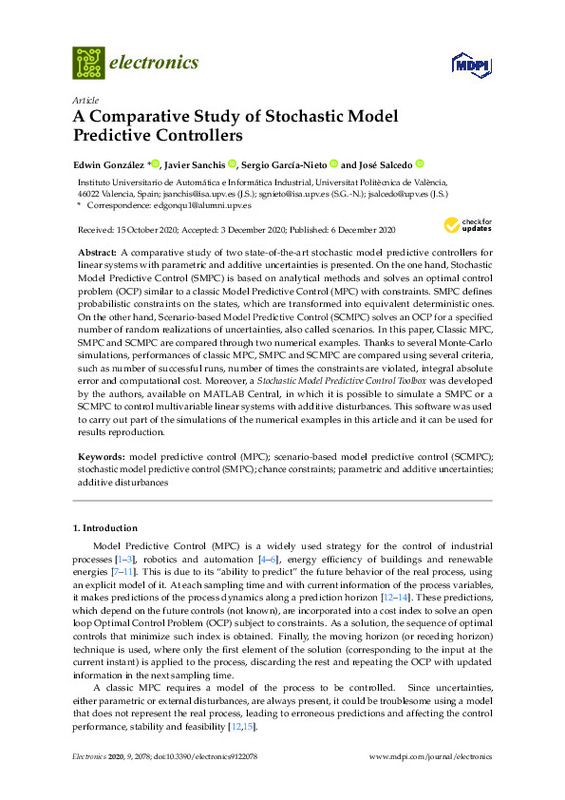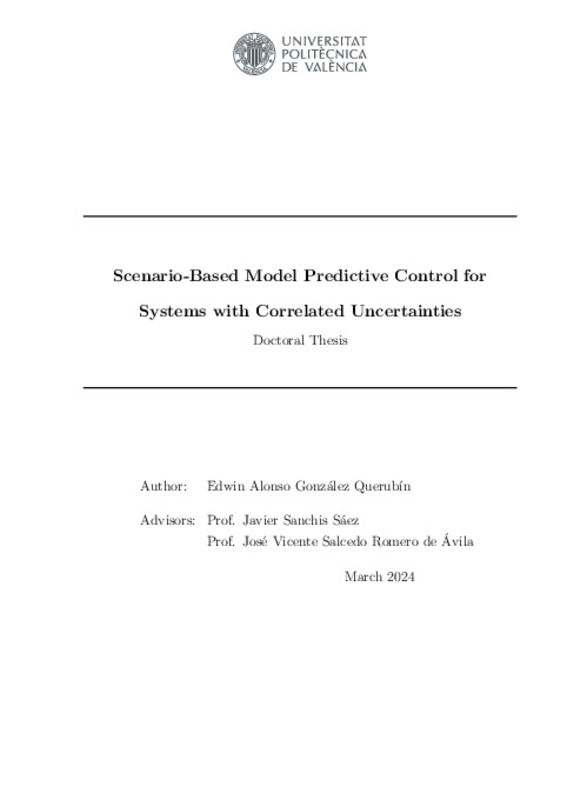JavaScript is disabled for your browser. Some features of this site may not work without it.
Buscar en RiuNet
Listar
Mi cuenta
Estadísticas
Ayuda RiuNet
Admin. UPV
Latent variable based model predictive control: Ensuring validity of predictions
Mostrar el registro sencillo del ítem
Ficheros en el ítem
| dc.contributor.author | Laurí Pla, David
|
es_ES |
| dc.contributor.author | Sanchís Saez, Javier
|
es_ES |
| dc.contributor.author | Martínez Iranzo, Miguel Andrés
|
es_ES |
| dc.contributor.author | Hilario Caballero, Adolfo
|
es_ES |
| dc.date.accessioned | 2014-07-11T09:07:22Z | |
| dc.date.issued | 2013-01 | |
| dc.identifier.issn | 0959-1524 | |
| dc.identifier.uri | http://hdl.handle.net/10251/38718 | |
| dc.description.abstract | This paper presents a methodology to constrain the optimisation problem in LV-MPC so that validity of predictions can be ascertained. LV-MPC is a model-based predictive control methodology implemented in the space of the latent variables and is based on a linear predictor. Provided real processes are non-linear, there is model-process mismatch, and under tight control, the predictor can be used for extrapolation. Extrapolation leads to bad predictions which deteriorates control performance, hence the interest in validity of predictions. In the proposed approach first two validity indicators on predictions are defined. The novelty in the two indicators proposed is they neglect past data, and so validity of predictions is ascertained in terms of future moves which are actually the degrees of freedom in the optimisation. Second, the indicators are introduced in the optimisation as constraints. Provided the indicators are quadratic, recursive optimisation with linearised constraints is implemented. A MIMO example shows how ensuring validity of predictions neglecting past data can improve closed-loop performance, specially under tight control outside the identification region. (C) 2012 Elsevier Ltd. All rights reserved. | es_ES |
| dc.description.sponsorship | The first author is recipient of a fellowship from the Spanish Ministry of Science and Innovation (FPU AP2007-04549). This paper is partially funded by projects DPI2008-02133/DPI, TIN2011-28082 and PROMETEO/2012/028. The authors gratefully acknowledge reviewers' comments. | en_EN |
| dc.language | Inglés | es_ES |
| dc.publisher | International Federation of Automatic Control (IFAC) | es_ES |
| dc.relation.ispartof | Journal of Process Control | es_ES |
| dc.rights | Reserva de todos los derechos | es_ES |
| dc.subject | Data-driven | es_ES |
| dc.subject | Model predictive control | es_ES |
| dc.subject | Latent variable | es_ES |
| dc.subject | Prediction | es_ES |
| dc.subject | Control relevant identification | es_ES |
| dc.subject | Validity of predictions | es_ES |
| dc.subject.classification | INGENIERIA DE SISTEMAS Y AUTOMATICA | es_ES |
| dc.title | Latent variable based model predictive control: Ensuring validity of predictions | es_ES |
| dc.type | Artículo | es_ES |
| dc.identifier.doi | 10.1016/j.jprocont.2012.11.001 | |
| dc.relation.projectID | info:eu-repo/grantAgreement/MEC//AP2007-04549/ES/AP2007-04549/ | es_ES |
| dc.relation.projectID | info:eu-repo/grantAgreement/MICINN//DPI2008-02133/ES/NUEVAS ESTRATEGIAS DE OPTIMIZACION MULTIOBJETIVO PARA LA IDENTIFICACION, CONTROL Y DISEÑO DE PROCESOS Y SISTEMAS/ | es_ES |
| dc.relation.projectID | info:eu-repo/grantAgreement/MICINN//TIN2011-28082/ES/DISEÑO E IMPLEMENTACION DE PILOTOS AUTOMATICOS PARA VEHICULOS AEREOS NO TRIPULADOS (UAVS) MEDIANTE TECNICAS DE OPTIMIZACION Y CONTROL AVANZADO/ | es_ES |
| dc.relation.projectID | info:eu-repo/grantAgreement/GVA//PROMETEO%2F2012%2F028/ES/EVO-CONTROL: CONTROL Y OPTIMIZACION DE PROCESOS INDUSTRIALES BASADO EN ALGORITMOS EVOLUTIVOS/ | es_ES |
| dc.rights.accessRights | Abierto | es_ES |
| dc.contributor.affiliation | Universitat Politècnica de València. Instituto Universitario de Automática e Informática Industrial - Institut Universitari d'Automàtica i Informàtica Industrial | es_ES |
| dc.contributor.affiliation | Universitat Politècnica de València. Departamento de Ingeniería de Sistemas y Automática - Departament d'Enginyeria de Sistemes i Automàtica | es_ES |
| dc.description.bibliographicCitation | Laurí Pla, D.; Sanchís Saez, J.; Martínez Iranzo, MA.; Hilario Caballero, A. (2013). Latent variable based model predictive control: Ensuring validity of predictions. Journal of Process Control. 23(1):12-22. https://doi.org/10.1016/j.jprocont.2012.11.001 | es_ES |
| dc.description.accrualMethod | S | es_ES |
| dc.relation.publisherversion | http://dx.doi.org/10.1016/j.jprocont.2012.11.001 | es_ES |
| dc.description.upvformatpinicio | 12 | es_ES |
| dc.description.upvformatpfin | 22 | es_ES |
| dc.type.version | info:eu-repo/semantics/publishedVersion | es_ES |
| dc.description.volume | 23 | es_ES |
| dc.description.issue | 1 | es_ES |
| dc.relation.senia | 231901 | |
| dc.contributor.funder | Ministerio de Educación y Ciencia | es_ES |
| dc.contributor.funder | Ministerio de Ciencia e Innovación | es_ES |
| dc.contributor.funder | Generalitat Valenciana | es_ES |







![[Cerrado]](/themes/UPV/images/candado.png)




